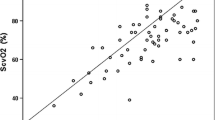Abstract
Cerbral oxygenation level during cardiopulmonary bypass (CPB) was measured using near-infrared spectroscopy as a monitor of cerebral circulation in 30 patients. Six adult cases with thoracic aortic aneurysm were operated on using selective cerebral perfusion (SCP). CPB was established under moderate hypothermic temperature in 9 adult cases (hypothermic group, lowest blood temperature during CPB; 25°C) and under normothermic temperature in 9 adult cases (normothermic group, lowest blood temperature during CPB; 34°C). In congenital cases (n=6), CPB was established under moderate hypothermic temperature (congenital grpoup, lowest blood temperature; 25°C). The oxyhemoglobin (HbO2) level showed a significant positive correlation with cerebral blood flow during SCP (r = 0.715). There was no significant correlation between SjO2 and HbO2 in the SCP group. The HbO2 levels in the hypothermic group after 30 and 60 min. from the initiation of CPB and 30 min. before the weaning of CPB were significant lower than the control level (p<0.05). HbO2 levels in the congenital group after 0, 30 and 60 min. from the initiation of CPB and 30 min. before the weaning of CPB were significantly lowr than the control level (p<0.01). The deoxyhemoglobin (HbR) level in the hypothermic group after 30 and 60 from the initiation of CPB and 30 min. before the weaning of CPB were significantly higher than the pre level (p<0.05). The mixed venous saturation (SvO2) in the normothermic group showed significant lower levels than those in the hypothermic group (p<0.01). However, there was no significant difference in HbO2 levels between the two groups. In conclusion, these results suggest that near-infrared spectroscopy may be a noninvasive and useful technique for the cerebral circulation monitorin during CPB.
Similar content being viewed by others
References
Reed GL III, Singer DE, Picard EH, DeSanctis RW: Stroke following coronary-artery bypass surgery. A case-control estimate of the risk from carotid bruits. N Engl J Med 319; 1246–1250, 1988
Tönz M, Mihaljevic T, von Segesset LK, Schimid ER, Joller-Jemelka HI, Pei P, Turina MI: Normothermia versus hypothermia during cardiopulmonary bypass. A randomized, controlled trial. Ann Thorac Surg 59: 137–143, 1995
Jöbsis FF: Noninvasive infrared monitoring of cerebral and myocardial oxygen sufficiency and circulatory parameters. Science 198: 1264–1267, 1977
Wyatt JS, Cope M, Delpy DT, Wray S, Reynolds EOR: Quantification of cerebral oxygenation and newborn infants by near infrared spectrophotometory. Lancet 2: 1063–1065, 1986
du Plessis AJ, Newburger J, Jonas RA, Hickey P, Naruse H, Tsuji M, Walsh A, Walter A, Walter G, Wypij D, Volpe JJ: Cerebral oxygen supply and utilization during infant cardiac surgery. Ann Neurol 37: 488–497, 1995
Wyatt JS, Cope M, Delpy DT, vander Zee P, Arridge S, Edward AD, Reynolds EOR: Measurement of optical path length for cerebral near-infrared spectroscopy in newborn infants. Dev Neurossci 12: 140–144, 1990
19: 535–538, 1990
2: 9–16, 1993
43: 1107–1114, 1995
Kurth CD, Steven JM, Nicolson SC, Chance Band Delivoria-Papadopoulos M: Kinetics of cerebral deoxygenation during deep hypothermic circulatory arrest in neonates. Anesthesiology 77: 656–661, 1992
23: 1011–1017, 1994
Patel RL, Turtle MR, Chambers DJ, James DN, Newman S, Venn GE: Alpha-stat acid-base regulation during cardiopulmonary bypass improves neuropsychologic outcome in patients undergoing coronary artery bypass grafting. J Thorac Cardiovasc Surg 111: 1267–1279, 1996
38: 567–572, 1990
van der Zee P, Cope M, Arridge SR, Essenpresis M, Potter LA, Edwards AD, Wyatt JS, McCormick DC, Roth SC, Reynolds EOR Delpy DT: Experimehally measured optical pathlength for the adult head, calf and forearm and the head of the new born infant as a function of inter optode spacing. Adv Exp Med Biol 316: 143–153, 1992
van der Linden J, Wesslén O, Ekroth R, Tydén H, von Ahn H: Transcranial Dopler-estimated versus thermodilution-estimated cerebral blood flow during cardiac operations. Influence of temperature and arterial carbon dioxide tension. J Thorac Cardiovasc Surg 102: 95–102, 1991
19: 306–307, 1989
12: 19, 1991
Croughwell ND, Frasco P, Blumenthal JA, Leone BJ, White WD, Reves JG: Warming during cardiopulmonary bypass is associated with jugular bulb desaturation. Ann Thorac Surg 53: 827–832, 1992
Bigelow WD, Lindsay WK, Harrison RC, Gorden RA, Greenfood WF: Oxygen transport and utilization in dogs at low body temperatures. Am J Physiol 160: 125–137, 1950
Author information
Authors and Affiliations
Rights and permissions
About this article
Cite this article
Ohata, T., Sawa, Y., Ohtake, S. et al. Evaluation of cerebral circulation during cardiopulmonary bypass using near-infrared spectroscopy. Jpn J Thorac Caridovasc Surg 46, 603–609 (1998). https://doi.org/10.1007/BF03217788
Received:
Accepted:
Issue Date:
DOI: https://doi.org/10.1007/BF03217788




